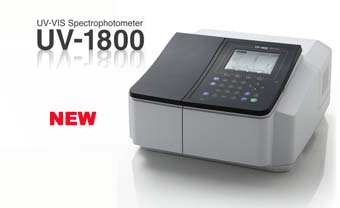Features
High resolution
Featuring the highest resolution in its class* (1 nm), the UV-1800 easily satisfies the standards of wavelength resolution demanded by the European Pharmacopoeia. Additionally, using a blazed, holographic grating with a Czerny-Turner mount results in a compact, high-throughput optical system. Stray light, wavelength repeatability and baseline stability have also been advanced to meet user requirements.
(*As of March 2007, according to Shimadzu research.)
Compact
Only 450 mm wide, the UV-1800 is one of the most compact instruments in its class, allowing installation in tight spaces. In comparison to the UV-1700, the required space has decreased by about 15%, and the width has narrowed by about 20%.
User Friendly
USB memory can be connected directly to the UV-1800. Users can now analyze data on a PC using UVProbe software. In addition, data for spectra and time-course curves can be displayed and saved with commercial spreadsheet software. Printing is possible to printers that support PCL control codes, e.g:
- HP Business Inkjet 1200
- HP Photosmart D5160
Using UVProbe software, provided standard with this instrument, makes it possible to control the UV-1800 with a PC. (A USB cable is required for connection to the PC.)
Security functions
Enabling the UV-1800 security functions makes it possible to restrict functions according to the user level.
Instrument validation functions
The UV-1800 offers compatibility with 9 JIS items. Wavelength accuracy, wavelength repeatability, resolution, stray light, photometric accuracy, photometric repeatability, baseline flatness, baseline stability, noise level.
Maintenance
The operating time of the deuterium (D2) lamp and the halogen (WI) lamp can be recorded and displayed. Consequently, the expected replacement period of the lamps can be ascertained when performing periodic inspections, minimizing downtime.
Measuring Modes
Equipped with a variety of measurement modes as standard in a stand-alone instrument, the UV-1800 enables you to perform a range of applications, including photometrics and protein quantitation.
Photometric Mode
Measures the absorbance or transmittance at a single wavelength or at multiple (up to eight) wavelengths. In multiple-wavelength measurement, calculations can be performed on the data obtained for up to four wavelengths, including the calculation of the difference between, or ratio of, the measurements obtained for two wavelengths.
Spectrum Mode
Obtains sample spectra using wavelength scanning. Changes in the sample can be tracked using repeated scans. Data processing operations, such as the enlargement or reduction of the spectra obtained, peak detection, and area calculations, are also possible.
Quantitation Mode
Generates a calibration curve from standard samples, and uses it to calculate the concentrations of unknown samples. Various combinations of wavelengths (1 to 3 wavelengths and derivatives) and calibration curves (K-factor and first-to-third order regression calibration curves) are possible.
Kinetics Mode
Measures the change in absorbance as a function of time, and thereby obtains enzymatic activity values. The kinetics measurement method or the rate measurement method can be selected. Using this mode in combination with an MMC-1600/1600C multi-cell holder (8/16 series multi-cell) or a CPS-240A cell positioner (6 cells) enables the consecutive analysis of multiple samples.
Biomethod Mode (provided as standard)
Capable of analyzing DNA and proteins using the following quantitation methods.
- Nucleic Acid Quantitation- Quantitates DNA or protein using the absorbance at 260/230 nm or 260/280 nm.
- Protein Quantitation
- Lowry method
- BCA method (using bicinchoninic acid)
- CBB method (using Coomassie Brilliant Blue G-250)
- Biuret method
- UV absorption method (direct measurement at 280 nm)








